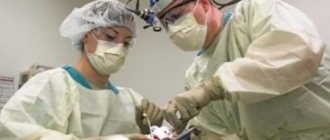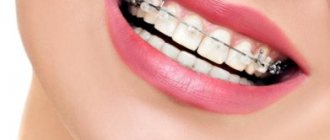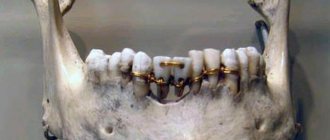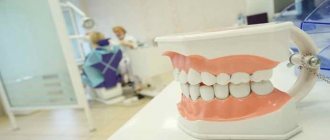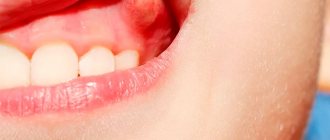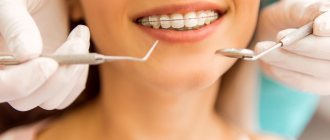24.11.2019
Many of us are faced with various problems related to teeth, for example, odontogenic maxillary sinusitis or chronic odontogenic sinusitis, which will be discussed today. These diseases are very similar and extremely unpleasant. The worst thing is that diagnosis requires modern equipment, so it is worth understanding the symptoms in detail in order to be able to determine the development of the disease and take timely measures.
What kind of disease
Odontogenic sinusitis is a complex disease. Infections penetrate from the affected tooth, resulting in inflammation in the mucous membrane, as well as the submucosal layer of the maxillary sinuses. The upper jaw has such a structure that the disease affects its back teeth. This is because the upper molars and premolars are very close to the maxillary sinuses and practically touch them. Because of this, a diseased tooth can easily provoke infection of the paranasal sinuses.
Most often, acute odontogenic sinusitis of the maxillary sinus develops exclusively in one of the sinuses: right or left, it depends on which side the affected tooth is located. Then the other side becomes infected, after which bilateral sinusitis occurs.
In some cases, the infection can spread to other sinuses, especially if the immune system is weak.
What is the connection between toothache and sinusitis?
With prolonged inflammation of the mucous membrane, bone tissue is affected, and the jaw is also affected, so teeth hurt with sinusitis quite often. If the upper molars are susceptible to caries, this may become a prerequisite for odontogenic inflammation. In this case, the patient will experience acute painful sensations. And if the trigeminal nerve is damaged, the pain will be dull.
Initially, teeth suffer from pain due to the inflammatory process. As it worsens, the nasal mucosa becomes severely swollen and causes stenosis of the small opening between the paranasal sinuses and the nasal cavity. A mucous secretion accumulates in the cavities, in which the active growth of pathogens begins.
Gradually, purulent contents strongly fill the cavity and begin to put pressure on the tissue, which provokes severe pain in the upper jaw. Pain in the teeth develops because the roots of the upper teeth and the maxillary sinuses are separated only by a thin septum.
Causes of sinusitis
The main reason for the development of the disease is infection from the affected tooth. This may happen in the following cases:
- Poor dental care, rare visits to the dentist. This leads to caries beginning to develop, and if everything is really bad, then nerve necrosis. The inflammation begins to gradually spread and ends up in the maxillary sinus.
- Seal. There are tooth roots that can be very close to the maxillary sinus, which is why when treating deep areas, the filling material can get into it.
- Is it possible to remove a tooth? After a tooth is removed, a channel is formed in its place, which allows infections to pass through. Provided that the root is not far from the sinus, inflammation is only a matter of time.
- Pathologies. It is not uncommon for this disease to form due to a cyst, especially if it suppurates.
That being said, there are several types of patients at risk of developing odontogenic sinusitis:
- Those who have undergone a large number of operations related to the upper jaw.
- People with weak immune systems.
Look at the root...of the tooth
I contacted an ENT doctor, and he referred me to... a dentist. They say that caries can cause my frequent sinusitis. This is true?
Victoria, Nizhny Novgorod
– Your attending physician acted absolutely correctly. In our practice, we quite often encounter so-called odontogenic sinusitis, which develops due to inflammatory processes in the apices of the roots of the teeth (most often from the 4th to the 6th), which, like atlases, support the lower wall of the maxillary sinus. Undermined by caries, they pose a serious threat. Listen to your doctor, get treatment from a dentist, and you may not have to suffer from constant sinusitis.
Symptoms of the disease: what to watch out for
Regardless of the causes of the disease, its symptoms are always the same:
- The sense of smell disappears, it can disappear completely.
- Migraines, feeling of weakness.
- Fever and chills.
- On teeth that have provoked inflammation, an aching sensation occurs; if you tap on them, a sharp, severe pain is felt.
When the disease worsens, the signs become more noticeable, and especially if it becomes purulent. When inflammation subsides, symptoms remain but become less intense, making them difficult to recognize.
If the cause of the infection is constantly located at the roots, as well as in the sinus in the teeth, then pain will be felt with sinusitis. Because of this, patients cannot eat solid food, although they feel absolutely healthy.
In addition to all this, a fistula may form. Its sign will be that liquid food consumed by a person will flow out of the nose along with pus. This only happens when you are in an upright position.
Which doctor should you contact?
Odontogenic sinusitis is a disease that should be treated by an otolaryngologist, but in cases where it has developed due to dental problems, you should contact a good dental surgeon.
It is worth noting that odontogenic chronic sinusitis is easy to detect, but finding the cause is not so easy. To do this, you will need to take a good medical history.
If a patient has odontogenic sinusitis, its main symptom is pain in the teeth. To accurately determine the disease, an examination is required, after which the patient is prescribed:
- A thorough examination of the oral cavity using x-rays.
- Diaphanoscopy.
- Puncture of the affected sinus.
- Examination of the nasal cavity using a rhinoscope.
- MRI and CT.
Eternal companion
Every winter I suffer from sinusitis. No matter what I do, no matter how I treat him, he still comes back to me. What is the reason?
Antonina, Vologda
– Alas, in your case, sinusitis has clearly become chronic. For a more accurate diagnosis, an experienced doctor just needs to look at an x-ray of the paranasal sinuses: if the mucous membrane of the maxillary sinus is thickened by more than 6 mm, this is considered a sign of chronicity of the process. Apparently, you have a pathology of the nasal cavity that predisposes you to frequent sinusitis (deviated nasal septum, pathology of anastomosis, etc.). As a rule, acute sinusitis begins with a common runny nose of viral origin. By infecting the cells of the nasal mucosa, the virus causes activation of the microbial flora, causing inflammation and swelling. Various reasons can lead to such a development of events. One of them is a decrease in general and local immunity due to certain stress factors - cold, heat, physical (overload, fatigue), psychological.
How to treat odontogenic sinusitis
If chronic odontogenic maxillary sinusitis is diagnosed, the doctor decides how odontogenic sinusitis will be treated, based on the patient’s condition.
In any case, antibiotics are necessarily prescribed, and their selection occurs individually, based on many factors. Caries and any other dental diseases are urgently eliminated. In most cases, the tooth has to be removed.
If the cause of dental sinusitis is any foreign body that is in the maxillary sinus, it must be surgically removed. The operation is performed under local anesthesia. Through the gum, the surgeon approaches the area that has been affected by the disease. This allows you to prevent the formation of surgical marks on the patient’s face.
If the case turns out to be severe, then to eliminate the disease it is necessary not only to remove the foreign body, but also to perform a sinusotomy. The essence of the operation is that its contents are sucked out of the sinus, the affected areas of the mucous membrane are eliminated, if there was a fistula, it is sutured, and its course is closed with a flap taken from the inside of the cheek. All this is performed using endoscopic equipment, which is introduced through the nasal cavity. It doesn’t matter what the patient’s treatment was, in any case, after it the patient is prescribed:
- Antibiotic treatment of sinusitis and teeth.
- Rinsing the nose with special solutions.
- Use of drugs with vasoconstrictor effects.
- In order to soften dry crusts, sea buckthorn oil is used.
In cases where sinusitis occurs during pregnancy, treatment is temporarily delayed until after labor has passed. Before them, physiotherapy, UHF and local antibiotics are prescribed.
In some cases, for pregnant women with illness, a puncture is used, which causes relief for some time.
Polyps: find and neutralize
Why are there often polyps with sinusitis and can they be treated?
Valery, Penza
– If sinusitis is advanced and becomes chronic, the nasal mucosa often changes - polyps begin to grow on it, which are sagging stretched by swelling, inflamed nasal mucosa. With each new swelling of the mucous membrane, the polyps increase in size and begin to interfere with the normal physiology of the nose.
It is believed that most polyps are of allergic (infectious-allergic) origin. But the cause of their occurrence is not fully known, so it is very difficult to fight them. Today, there are only symptomatic methods for treating polyps, aimed at removing and slowing down the process of their formation and increase in size. In our clinic (in addition to laser and radio wave treatment methods), we use one of the most modern techniques for removing polyps today using a shaver - a thin tube at the end of which there is a miniature cutting instrument. Having introduced it into the nasal cavity, we bring it to the polyp, turn on the “mini-cutter” and destroy the polyp, which is removed using a special suction. The success of surgical treatment is secured by the use of special hormonal sprays, which prevent further relapse of the disease and do not have a systemic effect on the body, acting only in the nasal cavity.
Folk remedies for the treatment of odontogenic sinusitis
Treatment with folk remedies is extremely dangerous; you can pay for it with your health, and sometimes even with your life. Often the disease develops and becomes purulent, which can cause severe complications, such as brain damage.
Skillfully assessing the patient’s condition, as well as the advanced state of the disease, the doctor prescribes the rehabilitation of odontogenic sinusitis using one of the methods. After a successful operation, doctors recommend the following:
- Rinsing the nasal cavity with medicinal herbs and infusions.
- Inhalation.
- Propolis infusion.
In general, it is impossible to cure the disease with home remedies.
Preventive measures
It is very important to take care of your teeth, as well as the entire oral cavity in general, so as not to get sick. It is advisable to visit the dentist at least once every six months. It is necessary to treat all diseased teeth, and you should only contact good specialists. It is highly recommended not to let diseased teeth get to the point where they need to be removed. Such an operation contributes to the development of sinusitis due to a diseased tooth, and generally impairs a person’s ability to chew. It is also worth following the following recommendations:
- Try not to visit places where there are a lot of people during the period of ARVI and flu.
- If necessary, you should take vitamins and immunomodulators.
- It is advisable not to allow any chronic pathologies to develop.
